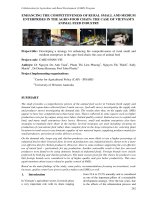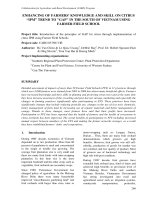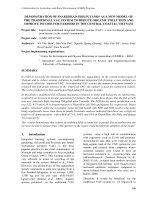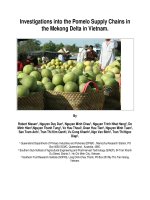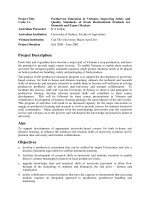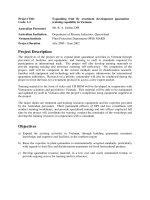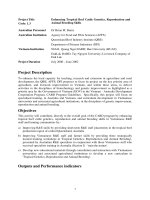Báo cáo nghiên cứu nông nghiệp " Enhancing the capacity of Vietnam to reduce the losses of grain and grain quality in storage through improved training " doc
Bạn đang xem bản rút gọn của tài liệu. Xem và tải ngay bản đầy đủ của tài liệu tại đây (90.53 KB, 14 trang )
Project Title
Code: 1.11
Enhancing the capacity of Vietnam to reduce the losses of
grain and grain quality in storage through improved training
Australian Personnel
Dr George Srzednicki
Dr Barry Longstaff
Australian Institution
University of New South Wales (UNSW)
Vietnam Institution
Sub. Post-Harvest Technology Institute in HCM city
Plant Protection Department, MARD
Project Duration
July 2000 to June 2002
Project Description
This project will enhance the capacity in Vietnam to 'train the trainers', extension workers
and staff responsible for the maintenance of quality of commodities during storage and
marketing.
PHTI will provide flexible integrated courses on various aspects of post-harvest
commodity quality management, with particular attention to containment and loss
reduction. The training group will also be able to develop new training modules
applicable to contaminant reduction in fruit and vegetables as strategies for monitoring
and management of contaminants in vegetables are further developed.
Objectives
a) This project will establish an improved training infrastructure and to train trainers and
extension workers employed on the commodity storage environment
b) The project will alleviate the national shortage of skilled trainers in the post-harvest
domain and the problems that national and regional organisations face in training such
trainers effectively and efficiently.
c) The creation of a training centre in HCMC will allow the project to access the
greatest pool of Vietnamese expertise in training for post-harvest. The project will also
take regional issues into account, by conducting several training courses at three
important regional centres in the second year.
Outputs and Performance indicators
Outputs
Performance Indicators
♦ Establishment of a dedicated
training facility at PHTI and
HCMC, in the centre of Vietnam's
major area of production of
durable commodities. This
facility would focus in training
trainers in the commodity storage
environment.
i) Purchase of computers for the PHTI centre
ii) Purchase of portable gas detection equipment
for practical sessions on fumigation
iii) Development of training manuals and
additional CAL modules in Vietnamese and
English
♦ Conduct a series of training
courses for industry trainers,
combining the CAL approach with
conventional lecturers and
practical sessions
i) Conduct general course for 24 participants in
HCMC, Year 1
ii) Conduct specialised training course, in
parallel, on Fumigation, Drying and Mycology and
Mycotoxins, in HCMC, Year 1
iii) Conduct general courses for 20 participants in
Hanoi, Can Tho and Dak Lak, Year 2
iv) Conduct specialised training course, in
parallel, on Fumigation, Drying and Mycology and
Mycotoxins, in Hanoi, Can Tho and Dak Lak, Year
2
♦ Review of success of project and
formulate implementation and
maintenance strategies with PHTI
i) Produce implementation and maintenance
manual, including a consideration of application to
containment reduction and quality management
strategies for fruit and vegetables
ii) Incorporation of recommendations into the
final report to AusAID
♦ Accountability
i) Produce interim reports to AusAID after 6,
12, and 18 months
ii) Produce final report within a month of
project's end
iii) Submit financial reports after 12 and 24
months acquitting the expenditure incurred
PROJECT COMPLETION REPORT
Executive Summary
The project had a single objective, to enhance the capacity of Vietnam to train trainers,
extension workers and staff responsible for the maintenance of quality of commodities
during storage and marketing. The project has been able to achieve or exceed all of its
original performance indicators, despite major budgetary problems that arose as a result
of the significant decline in value of the Australian dollar early in the project. The project
has been able to establish a viable training infrastructure at the Post-harvest Technology
Institute (PHTI), in HCMC, by providing computers, gas detection equipment and
Computer-Assisted Learning (CAL) system. In order to address the budgetary issues, it
was necessary to reduce the number of courses involving Australian personnel. A total of
102 people participated in these courses but, with additional people trained independently
by PHTI and the Plant Protection Department (PPD), the total increased to over 300,
almost double the original projection of 168. As PHTI had to limit numbers of
participants in training courses, due to the limited number of computers available, there is
clearly a considerable demand for training in this discipline. The participants ranged from
commercial fumigators to university lecturers and included a high proportion of women.
The activities of the Vietnamese collaborators have, therefore, more than compensated
for the negative effects of the budgetary problems stemming from the exchange rate
problems. The activities of our Vietnamese collaborators are very significant and indicate
their appreciation of the potential of the technology that they have been provided with by
the project. As the project progressed, staff from PHTI and PPD assumed increasing
responsibility for conduct of training courses and, by the end of the project, they were
running courses without Australian input. PHTI and PPD have indicated that they will
use the system on an even greater scale in the years to come.
One issue that arose in the final review of the project, which should be considered by
AusAID, was the need to develop a maintenance policy for the CAL software system.
Technologies and protocols will change over time, and the CAL system will need to be
updated to reflect these changes. The review committee thought that a workshop,
conducted every 2 or 3 years would be able to address this issue. Funding would be
needed to facilitate this workshop and the subsequent process of incorporating new
information.
1. Project Description
Background and preparation
In Vietnam, the average annual paddy loss is 13-16%, equivalent to about 1.6Mt of
harvested rice, valued in excess of AUS$500 million. About a quarter of these losses
occur in storage. Significant losses in quality also occur, in addition to these quantitative
losses. The potential savings from preventing a 0.5% weight loss by improving the
technical capability of the pest control workforce are thus considerable. The reduction in
weight loss, achieved through improved implementation of storage practices, required to
give a 10% return on the resources invested in this project is very small and is certainly
much less than 0.5%.
By late 1999, a collaborative project between Indonesia, Philippines, Thailand, Vietnam
and Australia developed a Computer-Assisted Learning (CAL) system to augment
conventional training methods. The package encompasses most important issues facing
staff involved in management of quality of grain in storage: grain drying, moulds and
mycotoxins, and pests. The package was integrated with conventional lectures and
practicals in training courses that were conducted in each country. Each course was
conducted primarily in the local language. A review of the success of the Vietnamese
component of this project, carried out with senior management of PHTI, concluded that
the project had been very successful and had demonstrated considerable potential. They
also recognised that this training approach would have further application in
implementation of contaminant reduction and quality management strategies for fruit and
vegetables. Factors limiting the widespread adoption of the technology in Vietnam
include a shortage of suitable computer hardware and the need to train trainers in further
development of new training modules and use of the package.
Adoption and integration of the CAL-based training system into the training regimes of
the participating organisations will lead to more effective training programs, particularly
as they have geographically-distributed workforces. There will also be substantial cost
savings for training programs. This will contribute to improvements in technology
transfer and training in the agricultural sector and, ultimately, to improved overall food
security, through reduced losses of vital food grains, leading to general improvements in
living standards. The more efficient use of chemical control measures will also reduce the
environmental impact of such measures.
By enhancing the capacity of PHTI, PPD and UAF to train trainers and personnel
involved in the management of commodity quality during storage, a wide range of groups
will derive direct benefits, including: commodity processing and storage units,
commodity export agencies, extension officers, and farmers associations. The project is
perceived by the Vietnamese as being of particular benefit to local women, who have
taken a great part in the management of agro-products quality during storage and
processing.
Lead Institution
The Department of Food Science and Technology of the University of NSW has a long
track record of successful collaboration with the Vietnamese organisations involved in
the project. Work with the University of Agriculture and Forestry, in Ho Chi Minh City
(UAF) began in 1993, with joint research work on the introduction of two-stage drying
system for grain to Vietnam, ACIAR-funded project, PHT/1990/006 (Applications of in-
store drying in the grain industry in South-East Asia), a project that also involved
Thailand and the Philippines. This project was completed in 1997 and led to collaboration
with PHTI, in Ho Chi Minh City, on detection of aflatoxin in maize and training of staff
in the feed-mills in this area. Mr. Nguyen Le Hung, from UAF, was awarded a PhD
scholarship from ACIAR in 1995 and he spent four years in the Department of Food
Science and Technology of the UNSW working on the development of a continuous
spouted-bed dryer. In 1998-99, a project (ACIAR project PHT/1997/131 (Computer-
Assisted Learning as a tool to improve storage pest management in key ASEAN
countries), jointly-funded by ACIAR and the AusAID APEC Support Program, enabled
UNSW to contribute a module on grain drying to the development and delivery of a
computer assisted learning package. A demonstration training course was conducted, at
PHTI, HCMC, in November, 1999.
Vietnamese partner institutions
The Post-Harvest Technology Institute
The Post-Harvest Technology Institute (PHTI) in HCMC, an institute within the Ministry
of Agriculture and Rural Development (MARD), is responsible for research, training and
extension for storage and processing of agricultural produce after harvest in Vietnam.
They also operate the Food Commodity Control Centre, which is responsible for
monitoring and quality certification of export produce. In the past, PHTI has collaborated
with Universities, the Extension Department of the Ministry of Agriculture and Rural
Development and with Australian agencies to organise training courses on aspects of
grain storage and processing for staff of agricultural trading companies, the Plant
Protection Department, the Department of National Reserve, and Universities from
throughout Vietnam. Most recently, it has been involved with CSIRO Entomology and
UNSW to develop a new computer-assisted learning system to improve training methods
(ACIAR Project PHT/1997/131).
Plant Protection Department
The Plant Protection Department (PPD) is the government institution responsible for
regulatory and quarantine security aspects of plant protection in Vietnam. Their role
includes pest management and situation forecasting, conduct of treatment measures, plant
quarantine and fumigation management, including the licensing of fumigators in
Vietnam.
The University of Agriculture and Forestry
The University of Agriculture and Forestry, in Ho Chi Minh City, trains both
undergraduates and graduates in varied branches of Agriculture and Forestry. The
University also has strong reputation for scientific research. The Department of
Processing and Conservation of Food and Agricultural Products of the University is
particularly strong and has collaborated with Australia (UNSW) and other countries in
research on grain dryers, with results that are being widely applied in the production
field.
1.2 Context and rationale
Agricultural production is very important source of export income for Vietnam and over
70% of people living in rural areas are involved in agricultural production. Agricultural
products constitute about 40% of Vietnam’s gross national product and, in 1998, they
exceeded AU$ 6 billion in value, more than twice the value of that exported only 8 years
previously. Almost 90% of this export income was derived from rice and 80% of the
balance from coffee.
In Vietnam, management of quality of durable commodities whilst in storage is relatively
underdeveloped and downgrading in quality of agricultural products, as a consequence of
insect infestation, fungal spoilage, or presence of unacceptable levels of pesticide
residues, is very common. Post-harvest grain losses in ASEAN region countries can be
quite high. Recent estimates suggest that average losses of paddy in Vietnam are as high
as 16% of production, or about 3-3.5Mt valued at over AUS$500 million. During the wet
season, this figure may rise to 30%. Losses sustained during storage constitute about a
quarter of the total and generally arise as a result of poor or inappropriate management.
Current technologies will remain the most economic methods for disinfesting and
protecting commodities for animal feed and seed but commodities for human
consumption will increasingly be protected by non-chemical means. In this scenario,
there will need to be an emphasis on reducing both residual insect populations within and
close to storages. Grain hygiene has long been recommended as a control procedure but
is rarely done properly in practice.
The Government of Vietnam has a high priority for upgrading procedures for maintaining
quality and safety of agricultural products in storage. In addition, Vietnam is a signatory
to the Montreal Protocol, which stipulates that use of methyl bromide as a general
fumigant must be phased out by 2015, owing to its ozone-depleting properties. Methyl
bromide is currently widely used in Vietnam as a rapid disinfestant and its future
unavailability will require significant shifts in pest management strategies to compensate
for its absence.
There are considerable differences between regions, in terms of the commodities grown
and volumes produced. The bulk of rice production occurs in the south of the country and
over 85% of export production is shipped out of the port of Saigon. Almost the same
proportion of coffee production also goes through that port, although most is actually
produced in the highlands.
1.3 Project objectives and scope at design
The project was designed to enhance the capacity of Vietnam’s Ministry of Agriculture
and Rural Development to train trainers, extension workers and staff responsible for
maintenance of quality of commodities during storage and marketing. In the first year of
the project, a training facility was to be established at PHTI, in Ho Chi Minh City,
allowing the project to access the greatest pool of Vietnamese expertise in training for
post-harvest operations. PHTI would provide flexible integrated courses on various
aspects of post-harvest commodity quality management, with particular attention to
contaminant and loss reduction. There would be conventional lectures and practical
sessions, but the courses would also use the CAL system, which would be significantly
enhanced. Several courses were to be run during this first year, ranging from an
introductory generalist course to more specialised courses on topics such as fumigation,
mycotoxin detection and grain-drying. In the second year, courses were to be conducted
in various regional areas of Vietnam. This would allow staff in these regions to access all
training resources, without need to travel to HCMC
This project would establish an improved training infrastructure and train trainers and
extension workers employed in the commodity storage environment. The project would
thus alleviate a national shortage of skilled trainers in the post-harvest domain and the
problems that national and regional organisations face in training such trainers effectively
and efficiently. By focussing at this level, the project would have greatest impact on
uptake of best practices in commodity storage and thus on reducing post-harvest losses.
This is highly relevant to AusAID’s strategy in the CARD program
In achieving these project objectives, existing relationships between institutions in both
countries would be further cemented and should lead to further productive collaboration
in the future
1.4 Implementation arrangements
The UNSW project team managed the activities within this project through Project
Manager, Dr. Barry Longstaff. He visited Vietnam, at the beginning of the project, to
meet with senior management of PHTI, PPD and UAF to plan course structure and
discuss revisions and extensions of the CAL system. During this visit, Vietnamese and
Australian responsibilities were finalised. Dr. Longstaff was then responsible for
subsequent co-ordination and day-to-day management of course development and
integration of course content into the revised computer-assisted learning package. PHTI
were responsible for arranging purchase of equipment, obtaining quotes which were
referred to the Project Manager for approval. PHTI were also responsible for the
logistical arrangements for the various training courses.
2. Appropriateness of Project Design and Objectives
2.1 Appropriateness of Objectives
Objective No (1, 2, 3,
etc)
Objective description Appropriateness
Rating
1 To enhance the capacity of Vietnam to
train trainers, extension workers and
staff responsible for the maintenance
of quality of commodities during
storage and marketing
5
2.2 Appropriateness of Design
PHTI and PPD attach considerable importance to this project because of increasing
demand for improved standards of storage. With the loss of methyl bromide, storage
managers will have to be more aware of the properties of available pest and quality
management procedures. More specifically, fumigators must clearly recognise their
responsibilities and understand basic and specialised fumigation techniques in both
theory and practice, so as to be able to choose the most suitable method of fumigation for
particular circumstances. They must also be aware of the impact of their actions on the
environment, so as to minimise pollution, and maintain the safety of their co-workers and
themselves. This means that licensing procedures will have to be more detailed and
rigorous.
Improving standards of storage and processing are also of great importance in developing
and maintaining a good international trading reputation. Arrival of infested or
contaminated commodities in certain countries can result in a downgrading of status and
mandatory treatment costs at the port of import. The ability to satisfy these needs is
confounded by a critical shortage of appropriately skilled trainers and extension workers.
A previous project, funded jointly by AusAID and ACIAR, created a Computer-Assisted
Learning (CAL) system that was judged to be a considerable success by PHTI
management. It was felt that this represented a significant step forward in training trainers
of quality management staff and also provided a unique suite of reference resources for
practitioners. Factors limiting the widespread use of the CAL system were identified as
shortages of skilled training personnel and of appropriate computer hardware. This
project addressed both of these issues through purchase of relevant hardware and training
of staff, both in disciplines relevant to commodity storage and in use of the system to
train quality management staff. By focussing on training of trainers and extension staff,
the project will have maximum impact.
Description of design feature Appropriateness
Rating
Establish a dedicated training facility at PHTI, HCMC, in the
centre of Vietnam’s major area of production of durable
commodities. This facility would harness expertise of the
majority of Vietnam’s experts in various disciplines and could
cater for trainees from all over Vietnam. It would focus on
training trainers and practitioners.
3
Conduct of a series of training courses for industry trainers,
combining the CAL approach with conventional lectures and
practical sessions.
3
Review success of project and formulate implementation and
maintenance strategies with PHTI
4
Accountability 4
3. Implementation Performance
3.1 Project Components and Outputs
Vietnam Objective Description Achievement
Rating
1
To enhance the capacity of Vietnam to train trainers,
extension workers and staff responsible for the
maintenance of quality of commodities during storage
and marketing
4
Output Performance indicator
Performance
Rating
1. Establish a
dedicated training
1. Purchase of computers for the PHTI
centre
4
2. Purchase of portable gas detection
equipment for practical sessions on
fumigation
4
facility at PHTI,
HCMC
3. Development of training manuals and
additional CAL modules in Vietnamese
and English
5
1. Conduct general course for 24
participants in HCMC, Year 1
5
2. Co
HCM
nduct specialised training courses in
C, Year 1
5
3. Conduct general courses for 20
rticipants in Hanoi, Can Tho and Dak
Lak, Year 2
pa
4
2. Conduct of a series
of training courses
for industry
trainers, combining
CAL with
conventional
lectures and
practical sessions
4. Conduct specialised training courses, in
parallel, on Fumigation, Drying, and
Mycology and Mycotoxins, in Hanoi,
Can Tho and Dak Lak, Year 2
3
3. Review success of
project and
formulate
implementation
and maintenance
strategies with
PHTI
1. Incorporation of recommendations into
the final report to AusAID.
4
1. Produce interim reports to AusAID after
6, 12, and 18months
4
2. Produce final report within a month of
the project’s end
4
4. Accountability
3. Submit financial reports after 12 and 24
months, acquitting the expenditure
incurred
4
This project experienced 2 major problems. The first was the delay in beginning the
project due to bureaucratic issues associated with the contract with AusAID/ITC.
Protracted negotiations between the parties delayed the start of activities until December,
2000, with no extension of the completion date. The second problem was the sudden and
unexpected decline of the Australian currency. The budget was developed when the
exchange rate was AUD=0.6USD. In the first quarter of the project, before any money
had been sent to the collaborating agency in Vietnam, the exchange rate had deteriorated
to AUD=0.48USD. As about 40% of the project budget was to be spent in Vietnam, this
had a very significant impact on delivery of the specified outcomes.
3.2 Project Outcomes
The project has been able to achieve or exceed all of its original performance indicators,
despite major budgetary problems caused by the exchange rate issue. The project has
been able to establish a viable training infrastructure at PHTI by providing computer
hardware, gas detection equipment and an improved CAL system. The number of courses
involving Australian personnel had to be revised to address the budgetary issues, but a
total of 102 people participated in these courses, compared to a revised projection of 112.
However, with the additional people trained by PHTI and PPD, the total increased to over
300, triple the revised projection and almost double the original projection of 168. The
participants ranged from commercial fumigators to university lecturers and included a
high proportion of women. In meeting or exceeding all original objectives, the project has
been an undoubted success.
The Vietnamese collaborators, PHTI and PPD, have been enthusiastic in their
appreciation and deployment of the technology and training provided by the project and
sustainability of the process into the future is secure. One issue that arose in the final
review of the project, which should be considered by AusAID, was the need to develop a
maintenance policy for the CAL software system. Technologies and protocols will
change over time, and the CAL system will need to be updated to reflect these changes.
The review committee thought that a workshop, conducted every 2 or 3 years would be
able to address this issue. Funding would be needed to facilitate this workshop and the
subsequent process of incorporating new information.
3.3 Sectoral Impact
The CAL system is designed to take cultural and sociological issues into account and
adoption and integration of such a system into training regimes of participating
organisations will lead to more effective training programs, particularly as they have
geographically-distributed workforces. There will also be substantial cost savings for
training programs. This will contribute to improvements in technology transfer and
training in the agricultural sector and, ultimately, to improved overall food security,
through reduced losses of vital food grains, leading to general improvements in living
standards. More efficient use of chemical control measures will also reduce the
environmental impact of such measures.
In Vietnam, average annual paddy loss is 13-16%, equivalent to about 1.6Mt of harvested
rice, valued in excess of AUS$500 million. About a quarter of these losses occur in
storage. Significant losses in quality also occur, in addition to these quantitative losses.
The potential savings from preventing a 0.5% weight loss by improving the technical
capability of the pest control workforce are thus considerable. The reduction in weight
loss, achieved through improved implementation of storage practices, required to give a
10% return on the resources invested in this project is very small and is certainly much
less than 0.5%.
By enhancing the capacity of PHTI, PPD and UAF to train trainers and personnel
involved in managing commodity quality during storage, a wide range of groups will
derive direct benefits, including: commodity processing and storage units, commodity
export agencies, extension officers, and farmers associations
The project is perceived by the Vietnamese as being of particular benefit to local women,
who have taken a great part in the management of agro-products quality during storage
and processing.
3.4 Costs and Financing
To be done.
3.5 Monitoring of project
As indicated above, UNSW, through the Project Manager, was responsible for the
manageing and, therefore, monitoring progress of the project. As a result of the budgetary
problems discussed elsewhere, and after expressing UNSW’s concerns to ITC, it was
necessary for the Project manager to visit PHTI and develop a revised and achievable set
of outcomes with a new timetable.
Reports were compiled by the Project Manager and reviewed by Dr. Srzednicki,
Professor Le Van To and Mr. Duc, prior to submission to AusAID every six months.
Reports to the Government of Vietnam were the responsibility of Professor Le Van To
and, later, Mr. Duc.
Acquittal of funds has been done in accordance with normal UNSW procedures and
financial reports submitted to AusAID after 1 and 2 years.
3.6 Technical Assistance, Training and Capacity Building
The project has provided instruction to over 300 people in the past 2 years. They have
come from diverse professional backgrounds, including professional fumigators, grain
store managers, pest control operatives, university staff and other trainers, PPD
inspectors. The people have all have gained greater knowledge and understanding of the
complexities involved in maintaining commodity quality during storage. Those involved
in training also developed new skills in using CAL as an integral part of teaching.
Practicing fumigators who attended the specialist fumigation course are now aware of
what is required to achieve ‘best practice’. They are also now aware of occupational
health and safety issues involved in fumigation. The project has thus directly addressed
issues raised in Section 1.3, namely shortage of skilled trainers in the discipline and
promotion of industry ‘best practice’ and has substantially enhanced the capacity of the
collaborators to deliver highly effective, up-to-date training courses to this sector.
The Australian team were nominated in the original proposal and have worked together
very effectively. Similarly, prior ACIAR and AusAID projects had already established
good working relationships with the Vietnamese collaborators, which were strongly
reinforced during this project. There was clearly a desire by both groups to continue to
build on this productive relationship into the future.
This project was designed around running a range of training courses in major centres
throughout Vietnam and, apart from being unable to run any in the coffee-growing
highland region, because of budgetary problems discussed elsewhere, the goals were
achieved. However, PHTI were able to carry out a course in Dac Lac independent of
Australian involvement. PHTI were forced to restrict the number of participants involved
in most courses, primarily because of the limited number of computers available. This
indicates a strong desire for improved training within the sector.
3.7 Management of Constraints, Issues, Risks and Change
This project experienced 2 major problems. The first was the delay in beginning the
project due to bureaucratic issues associated with the contract with AusAID/ITC.
Protracted negotiations between the parties delayed the start of activities until December,
2000, with no extension of the completion date. The second problem was the sudden and
unexpected decline of the Australian currency. The budget was developed when the
exchange rate was AUD=0.6USD. In the first quarter of the project, before any money
had been sent to the collaborating agency in Vietnam, the exchange rate had deteriorated
to AUD=0.48USD. As about 40% of the project budget was to be spent in Vietnam, this
had a very significant impact on delivery of the specified outcomes. As a result, and after
expressing UNSW’s concerns to ITC and being advised to revise project outputs to
compensate for the budgetary shortfall, it was necessary for the Project manager to visit
PHTI and develop a revised and achievable set of outcomes with a new timetable.
3.8 Project Management
We believe that the project management has successfully addressed the issues mentioned
above and all revised project objectives have been met or exceeded. We believe that the
management performances of UNSW and especially the Vietnamese collaborating
institutions (PHTI and PPD) have been excellent throughout. UNSW is rated as fully
satisfactory, at 4, whilst PHTI and PPD are rated at 5, because they both ran several
training courses, using the CAL system, training a total of about 200 people, without
input from the Australian institutions.
4. Performance and Outcomes
4.1 Assessment of Performance Against Objectives and Design
The project has been able to achieve or exceed all of its original performance indicators,
despite the exchange rate problems. The project has been able to establish a viable
training infrastructure at PHTI, in HCMC, by providing computer hardware, gas
detection equipment and an improved CAL system. The number of courses involving
Australian personnel had to be revised to address the budgetary issues but a total of 102
people participated in these courses, compared to a revised projection of 112. However,
with the additional people trained by PHTI and PPD, the total rises to over 300, triple the
revised projection and almost double the original projection of 168. The activities of the
Vietnamese collaborators have, therefore, more than compensated for the negative effects
of the budgetary problems stemming from the exchange rate problems. The activities of
our Vietnamese collaborators are very significant and indicate their appreciation of the
value of the technology that they have been provided with by the project. They have
indicated to us that they will use the system on an even greater scale in the years to come.
As PHTI had to limit numbers of participants in training courses, due to the limited
number of computers available, there is clearly a considerable demand for training in this
discipline.
4.2 Sustainability
The collaborating institutions have indicated and clearly demonstrated their support for
the project activities and are very keen to continue and expand their use of this training
approach. As the project progressed, staff from PHTI and PPD assumed increasing
responsibility for conduct of training courses and, by the end of the project, they were
running courses without Australian input.
The major constraint to more widespread uptake of the approach is the limited number of
computers available at present. However, the institutions involved have indicated that
they will continue to invest in infrastructure in the coming years so that this constraint
will become less significant.
The only recurrent issue is the need to update content periodically, as regulations and/or
technologies change. This could be done most effectively through workshops (probably
every two or three years) involving relevant agencies in Vietnam, Australia and other
interested countries.
In terms of others impacts, improving the general level of training in this sector will lead
to a variety of benefits which will add to the sustainability of the project outcomes. It will
enhance Vietnam’s ability to comply with the requirements of the Montreal Protocol as it
phases out its use of methyl bromide as a general fumigant. More efficient use of
chemical control procedures will reduce environmental contamination and improve
worker occupational health and safety circumstances. Vietnam will be able to reduce
losses of vital food grains, leading to general improvements in living standards.
Vietnamese women, who have taken a great part in the management of agro-products
quality during storage and processing, will benefit from the project because the project is
essentially gender-neutral, when compared to current training systems.
Overall rating of the sustainability of the project outcomes is between 4 and 5.
4.3 Development Impact
The project has built on previous investments by both AusAID and ACIAR, allowing for
the full-scale delivery of an enhanced training package and program. By facilitating the
transfer of this technology to Vietnam, the project has enhanced its capacity to train its
trainers and consequently its commodity storage personnel, which will have a significant
impact on regional development. This will allow these Vietnam to reduce its losses of
vital food grains, leading to general improvements in living standards. As indicated
above, it will also have environmental consequences because it will enhance Vietnam’s
ability to comply with the requirements of the Montreal Protocol as it phases out its use
of methyl bromide as a general fumigant. More efficient use of chemical control
procedures will reduce environmental contamination and improve worker occupational
health and safety circumstances.
A further benefit will be an enhanced ability to provide clean, high quality commodities
to export markets. This ability may also result in access to new, more demanding
markets.
5. Conclusions
5.1. Overall assessment
In meeting or exceeding all original objectives, the project has been an undoubted
success. Our Vietnamese collaborators, PHTI and PPD, have been enthusiastic in their
appreciation and deployment of the technology and training provided by the project and
sustainability of the process into the future is secure. Two issues arose in the final review
of the project that should be considered by AusAID. First, there will be a need to develop
a maintenance policy for the CAL software system. Technologies and protocols will
change over time, and the CAL system will need to be updated to reflect these changes.
The review committee thought that a workshop, conducted every 2 or 3 years would be
able to address this issue. Funding would be needed to facilitate this workshop and the
subsequent process of incorporating new information.
The second, broader issue involves storage of perishable commodities. Fresh fruit and
vegetables are very important sources of income for rural communities and are, in many
ways, more difficult to store than their durable counterparts. The processes and
technologies involved are quite different from those employed in storage of durable
commodities and in Vietnam and surrounding countries there is an overwhelming need to
improve storage methods for perishable commodities. PHTI, in particular, would be very
interested in participating in development of an equivalent computer-based training
system for such commodities.
5.2 Lessons Learned
The biggest problem that faced this project, and probably all institutions involved in the
first round of CARD, was the dramatic decline in value of the Australian currency in the
first quarter of the project. The inability of AusAID to compensate for this gave rise to a
number of consequences, not least of which was potential damage to Australia’s image as
a donor. For this project, about 40% of the budget was to be spent in Vietnam and the
20% devaluation had a major impact, requiring considerable revision of both number and
location of training courses conducted and a reduction in visits by Australian workers.
The question that arises from this situation is how do lead institutions prevent this
happening again? A normal mechanism would be the inclusion of a contingency item in
the budget but this is not allowed under the rules of the CARD program. It is suggested
that AusAID consider either allowing institutions to include a contingency component in
budgets or for it or its managing agency to retain a proportion of the funds centrally for
this purpose.


